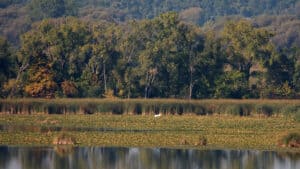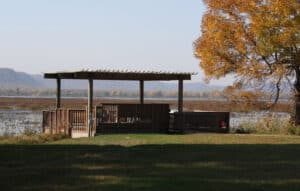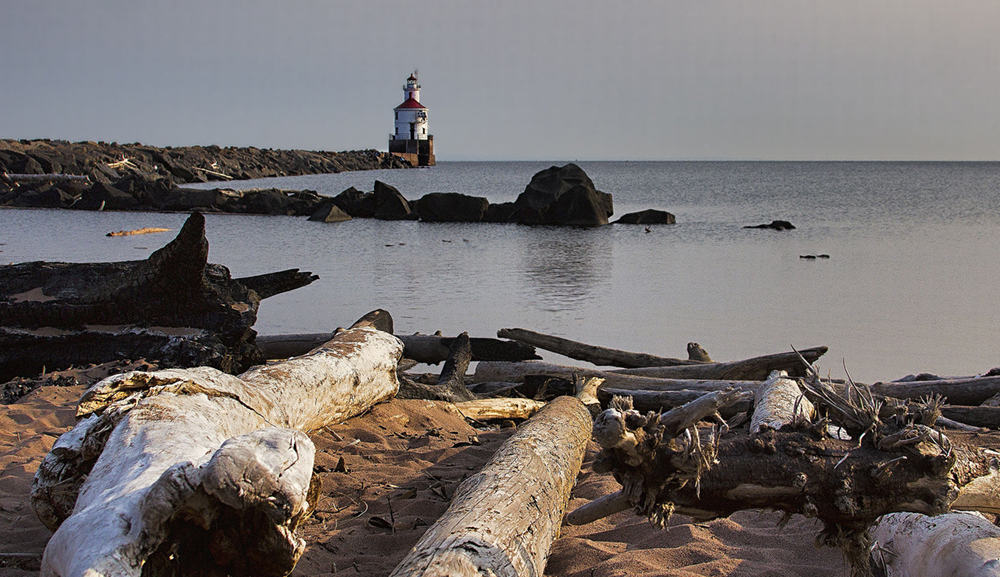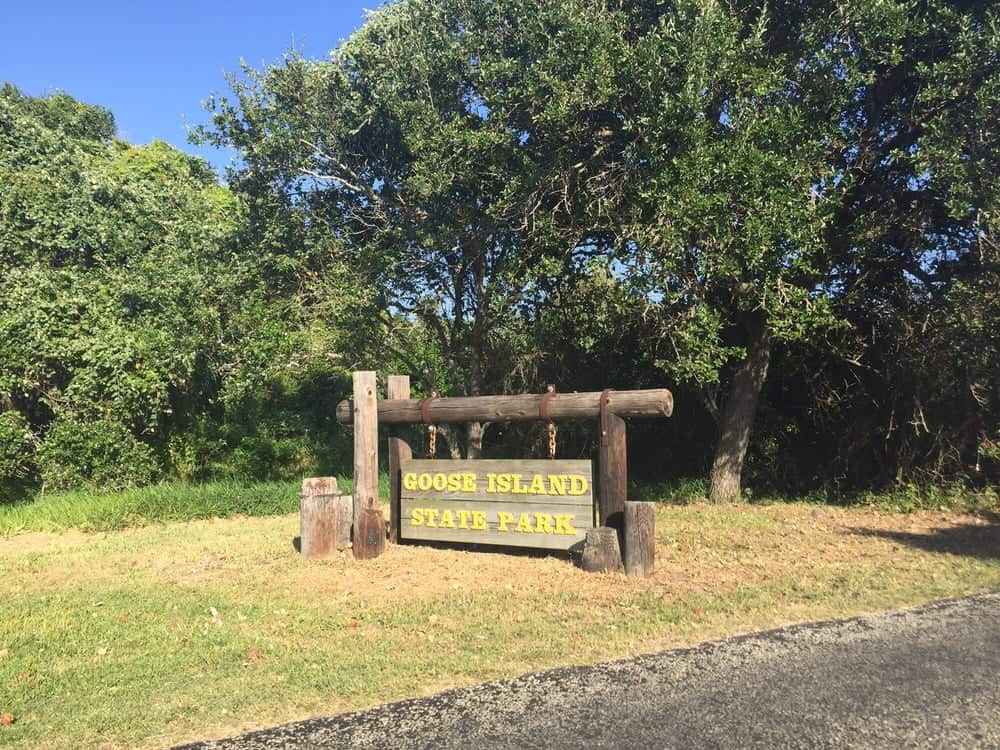Barkhausen Waterfowl Preserve
2024 Lakeview Drive
Suamico, WI 54173
(920) 448-4466
Located five miles north of Green Bay on the west shore of the bay, the Barkhausen Waterfowl Preserve features more than 900 acres of forest, meadows, and wetlands. Before setting out on the nine miles of hiking trails, stop in at the West Shores Interpretive Center, which offers programs throughout the year and a variety of hands-on exhibits. Be sure to check the bird feeders behind the center, which in winter might host American tree sparrows and a variety of finches. If you visit during peak migration, from early to mid-October, you may see mallards, wood ducks, gadwalls, wigeon, teal, and coots.
The preserve also boasts an impressive list of nesting birds, which include northern saw-whet owl, pileated woodpecker, American woodcock, mourning warbler, and northern waterthrush. In late summer and early fall, keep a lookout for snowy egrets, which can occasionally be found feeding in the impoundments along the entrance road.
Crex Meadows

P.O. Box 367
Grantsburg, WI 54840
(715) 463-2896/2739
This 30,000-acre complex of wetlands, flowages, marsh, brush prairie, and forest lies just north of Grantsburg in western Burnett County. Stop at the Visitor Center to pick up a map and bird list; more than 270 species have been seen in the state-owned wildlife area, including rarities like burrowing owl and western kingbird. Trumpeter swans can be found on the flowages during summer, and osprey and bald eagles are common. With the largest remnant of brush prairie in the state, Crex is also home to sharp-tailed grouse.
Yellow-headed blackbirds, northern harriers, American bitterns, and Le Conte’s sparrows can be found during summer. Waterfowl numbers peak in October, with large numbers of snow geese and ducks. In late October and November, sandhill cranes congregate by the thousands at night, spreading out to neighboring fields at sunrise with a deafening clamor.
The 1,800-acre Phantom flowage is considered by many to be the best birding area in Crex since it provides nesting habitat for many species of waterfowl, black terns, sora and Virginia rails, and other marsh denizens. Look for these birds, as well as warblers, from the observation area along Phantom Lake Trail.
Horicon National Wildlife Refuge

W4279 Headquarters Road
Mayville, WI 53050
(920) 387-2658
Regarded by many as Wisconsin’s premier bird watching spot, Horicon Marsh made the list of the American Bird Conservancy’s Globally Important Bird Areas. Dubbed “the Everglades of the North,” the 32,000-acre restored marshland is the largest freshwater cattail marsh in the United States. Horicon is the largest stopover site for migrant Canada geese in the Midwest, with peak one-day counts of 200,000 during the fall, and also serves as the largest nesting grounds for redheads east of the Mississippi. The refuge receives about 400,000 visitors a year, many during fall migration.
Six miles of hiking trails and an auto tour provide good viewing opportunities within the refuge; many birders also pull off the road along Highway 49 east of Waupun to scan the marsh for teal, wigeon, pintails, and other waterfowl.
Great egrets are common in the refuge, with cattle and snowy egrets sometimes found in late summer. Little blue and tricolored herons are less common. Records exist for American avocet, black-necked stilt, glossy ibis, and black-bellied whistling duck—all rare in Wisconsin.
Look and listen for soras and other rails along the Egret Trail, a floating boardwalk. Bobolinks and dickcissels breed in grassy areas within the refuge, with yellow-headed blackbirds and American white pelicans also summer residents.
Lake Superior/North Woods Birding and Nature Trail
(800)432-TRIP
This mapped auto trail is the first segment of a highway-based system that will showcase some of the best bird watching opportunities in the state. The first of five to be released, the Lake Superior/North Woods Birding and Nature Trail features eighty-eight sites in eighteen northern counties.
Starting at Crex Meadows in northwestern Wisconsin, the trail traverses the state and includes sites in the Nicolet and Chequamegon National Forests, home to northern species such as black-backed woodpeckers, boreal chickadees, and gray jays. Lakes in the area serve as prime fishing grounds for bald eagles and ospreys.
At the northern Great Lakes Visitor Center on the Bayfield Peninsula, near Ashland, you can view Lake Superior and the Apostle Islands from a five-story observation tower or watch for birds while exploring cedar wetland from the boardwalk.
The Spread Eagle Barrens Natural Area in Florence County is another interesting stop along the trail. This unique landscape is dominated by scattered jack pine, red pine, scrub oak, and quaking aspen. Look for northern harriers, upland sandpipers, clay-colored sparrows, and northern ravens. Mammals include black bear, fisher, badger, coyote, red fox, and white-tailed deer.
Sandhill Wildlife Area
1715 Highway X
P.O. Box 156
Babcock, WI 54413
(715) 884-2437
In late October, visit the Sandhill Wildlife Area near Babcock to see the largest concentration of staging sandhill cranes in the state. More than a thousand cranes arrive each evening after feeding in adjacent fields in central Wisconsin’s Wood County.
You can see the cranes, plus a variety of ducks, from the marsh observation tower. A second tower offers good views of a prairie restoration area and its resident bisons, while a third is situated atop a 200-foot high rocky outcrop.
The self-guided Trumpeter Trail Auto Tour, open from April to November, winds through fourteen miles of varied habitats. Look for eastern bluebirds near nest boxes in the grassland, which is also home to the endangered Karner blue butterfly. Wood ducks, pied-billed grebes, herons, and rails can sometimes be found in the ditches and marshy areas along the drive. In spring and summer, look—and listen—for ruffed grouse, wood thrushes, and ovenbirds in the wooded areas.
Schlitz Audubon Center
1111 East Brown Deer Road
Milwaukee, WI 53217
(414) 352-2880
Located fifteen minutes north of downtown Milwaukee on the shore of Lake Michigan, this 185-acre sanctuary features ponds, ravines, woodlands, and prairies, plus six miles of hiking trails. Before hitting the trails, check out exhibits in the new Dorothy K. Vallier Environmental Learning Center, touted one of the most environmentally sensitive buildings in the nation.
A 60-foot observation tower near the parking lot provides a good vantage point for scoping the lake. During spring, look for redheads, ring-necked ducks, common goldeneyes, and long-tailed ducks. Late fall and winter sightings have included western grebe, harlequin duck, and all three scoter species. Watch for hawks on fall days when there are strong westerly winds.
In all, 252 species have been recorded at the center, including rarities such as purple sandpiper and northern saw-whet owl. Spring migrants have included uncommon species such as white-eyed vireo, yellow-breasted chat, hooded warbler, summer tanager, and green-tailed towhee. About a dozen warbler species usually are present at the center in early June.
Trempealeau National Wildlife Refuge

W28488 Refuge Road
Trempealeau, WI 54661
(608) 539-2311
Located at the confluence of the Trempealeau and Mississippi Rivers, this 6,200-acre refuge is a stopover point for an estimated half million waterfowl during migration, including one-fifth of the world’s population of canvasbacks. Since the access road to the refuge is occasionally closed due to flooding, you might want to call first if you’re traveling some distance to this site.
The Pine Creek dike, one of several used to regulate water levels, offers good views of waterfowl, which during migration include large numbers of mallards, wood ducks, Canada geese, and tundra swans.
A self-guided auto tour will take you past prairies where you might catch a glimpse—or hear the songs—of Savannah sparrows or eastern meadowlarks. Field and grasshopper sparrows are frequently seen, with dickcissels less common. Look for eastern bluebirds near nest boxes in spring.
Osprey, northern harriers, and bald eagles all nest within the refuge. Lucky visitors might also see a red-shouldered hawk, unusual this far north, in the refuge’s floodplain forests.
University of Wisconsin Arboretum
1207 Seminole Highway
Madison, WI 53711
(608) 263-7888
Because of its many lakes and diverse habitats, the Madison area offers many great birding venues, including the University of Wisconsin Arboretum. Madison bird watchers flock to the arboretum each spring to catch the waves of migrating birds passing through. The area along McCaffrey Drive, which runs through the arboretum along Lake Wingra, teems with warblers in early May after a south wind pushes a warm front through the area.
Several parking lots lead to a network of more than twenty miles of trails, including several boardwalks, which provide easy access to diverse habitats. After picking up a trail map in the visitor’s center, you can head into the arboretum’s formal gardens, where wild turkeys are sometimes seen. Eastern bluebirds use many of the twenty-five nest boxes placed in the garden. In nearby Wingra Woods, look and listen for barred owls.
In March, American woodcocks perform aerial acrobatics above Curtis Prairie, the world’s first tallgrass prairie restoration. In summer, watch goldfinches feed on seed as you walk through the prairie’s dazzling display of grasses and flowers.
Wisconsin Point
Lake Superior
(715) 394-0270
Jutting into Lake Superior at the state’s northern tip, this sand spit serves as a rest stop for songbirds, raptors, and shorebirds funneled through the area during migration. When weather conditions are right for bird watchers, but not so right for birds, the point acts as a migrant trap. State rarities, such as parasitic jaeger and Cassin’s kingbird, are sometimes blown in and get birding hotlines buzzing in the area.
Some of the best birding here occurs in March, with bald eagles feasting on rough fish discarded from the catch and left on the ice. At this time of year, also look for great black-backed and glaucous gulls on the ice among the herring and ring-billed gulls. Ducks gather in large numbers as the ice melts, and raptors are often seen overhead.
Peak warbler migration occurs around mid-May, also a good time to look for red-necked grebes and common loons. Summer shorebirds include ruddy turnstones and buff-breasted sandpipers, sometime seen on mudflats on the eastern end of the bay.
In winter, look for snowy owls, often seen sitting on the ice off the point, as well as red crossbills and pine grosbeaks in the pines.
Wyalusing State Park
13081 State Park Lane
Bagley, WI 53801
(608) 996-2261
Spring is a great time to visit Wyalusing State Park in southwestern Wisconsin, where the Mississippi and Wisconsin Rivers meet near Prairie du Chien in Grant County. Stop at the park office to pick up a map and bird list, which includes an impressive list of songbirds infrequently found in the state: yellow-breasted chat, northern mockingbird, worm-eating warbler, tufted titmouse, and other species more commonly found to the south.
Continue on to one of the park’s scenic overlooks, where you can watch for soaring turkey vultures and bald eagles while enjoying a breathtaking view. Listen for wild turkeys and pileated woodpeckers as you walk the park’s twenty-four miles of trails. In spring, look for prothonotary warblers, Louisiana waterthrushes, and wood ducks at the boat landing and on the trails along the river bottom. Bobwhite, bobolinks, and lark and Henslow’s sparrows are sometimes seen in the grassy area around the park entrance road.




